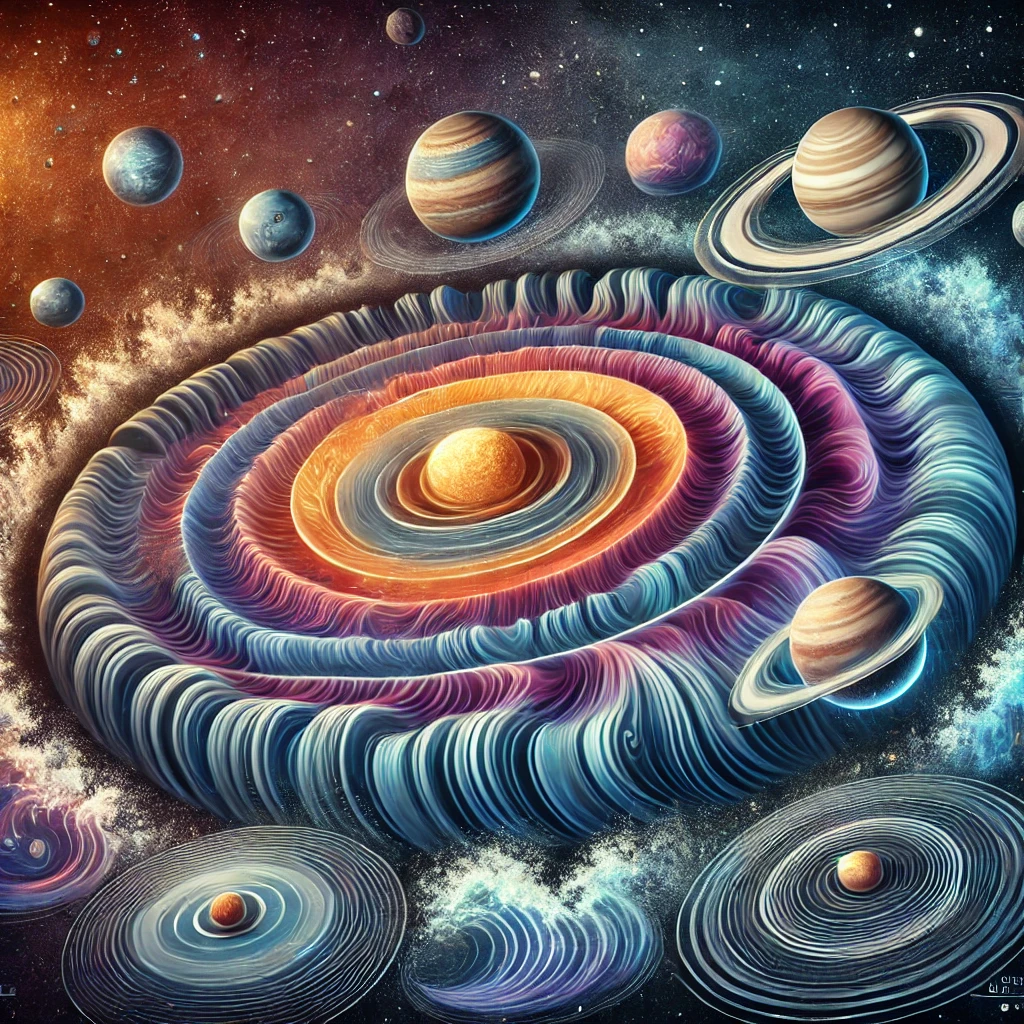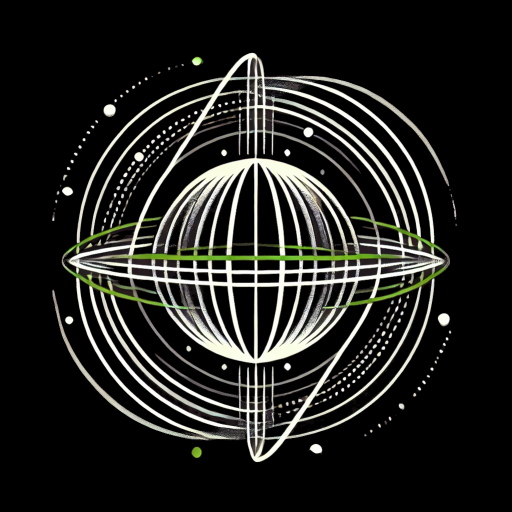
In the Vibrational Field Theory, the formation of planets is seen not just as a process driven by gravity and the accumulation of dust and gas, but as a manifestation of the self-organization of vibrations within the universal field. This theory views planets and other celestial bodies as stable vibrational systems that emerge naturally as the field’s energy coalesces into larger structures over time.
How Do Planets Form?
Traditionally, we understand planetary formation as the result of gravity pulling together dust, gas, and debris in a process that takes millions of years. In Vibrational Field Theory, gravity is still central, but it is seen as a result of low-frequency vibrations in the field. As these vibrations interact, they cause matter to clump together and eventually form planets.
Let’s break it down step by step.
The Vibrational Field and Planetary Formation
In the early universe, space was filled with clouds of gas and dust. These clouds are made of particles, which, in this theory, are localized vibrations in the field. As time passes, these vibrational patterns begin to interact with one another. Instead of thinking of particles as solid objects, imagine them as ripples in a vast, invisible ocean. The interactions between these ripples—driven by gravitational forces—cause some areas of the field to become more densely packed with energy.
- Gravity as Vibrational Interaction: In classical physics, gravity is the force that pulls matter together. In Vibrational Field Theory, gravity is a result of how these vibrational patterns interact and create distortions in the field. Large objects, like stars or black holes, create deep “wells” in the field, and smaller objects, like gas particles, get pulled into these wells due to the vibrations they create.
Dust and Gas to Planetesimals
As the dust and gas in space vibrate and interact through gravitational forces, they begin to stick together. Over time, these small particles form planetesimals—early-stage building blocks of planets. Each planetesimal is a cluster of vibrational modes that has found stability in the field. These smaller bodies continue to collide and merge, their vibrations interacting and amplifying, until they grow into full-fledged planets.
Vibrational Stability
The key here is vibrational stability. In the chaotic early universe, only certain vibrational patterns can survive long enough to form stable structures. These stable structures are what we recognize as planets. Imagine different vibrations in a string instrument: only certain frequencies (notes) produce stable sounds that we can hear, while others cancel out. In the same way, the stable patterns that emerge from the vibrating dust and gas become planets, while the unstable patterns disappear.
- Example: Think of the early solar system as a massive orchestra, with each particle vibrating at its own frequency. Over time, these vibrations “find harmony” as the particles come together to form planets.
Planets as Stable Vibrational Systems
Once formed, planets remain stable because their vibrational energy is balanced. A planet is essentially a mass of vibrating particles that has found equilibrium. These vibrations are slow and dense, giving planets their solidity and mass. They are much lower in frequency compared to the more energetic, high-frequency vibrations that create light or electromagnetic forces.
Long-Term Stability
Planets remain stable for billions of years because the vibrations in the field reinforce their structure. The gravitational field of a planet, in this theory, is a result of how its mass (vibrations) distorts the space around it. The more massive the planet, the greater the distortion, and the stronger its gravitational pull.
- Real-World Example: Earth, for instance, is a highly stable vibrational system. Its mass and gravitational pull are a result of the interactions between all the particles (vibrations) that make up the planet. These vibrations maintain the Earth’s shape and structure over time.
The Formation of Moons and Other Satellites
The same principles that govern planetary formation also apply to moons and other natural satellites. In the early stages of planetary formation, some of the material that doesn’t get incorporated into the planet itself forms smaller bodies, which become moons. These moons, like planets, are self-organized vibrations that find stability orbiting their parent planets.
Orbit as a Vibrational Balance
A moon’s orbit can be understood as a balance of vibrational forces. The moon’s gravitational pull is a vibration that interacts with the planet’s vibrations, and the result is a stable orbital pattern. Just as a musical note can resonate in harmony with another note, a moon can remain in a stable orbit around a planet due to the balance of their vibrational energies.
Planetary Atmospheres: A Layer of Vibrations
One of the unique features of planets like Earth is their atmosphere. In Vibrational Field Theory, a planet’s atmosphere is another manifestation of its vibrations. The particles in the atmosphere are less tightly bound than the solid surface of the planet, but they still vibrate within the planet’s gravitational field.
- Energy Interactions: The atmosphere contains gases like oxygen and nitrogen, which vibrate at higher frequencies than the solid ground. These vibrations help trap heat from the Sun (also a form of vibrational energy), which keeps the planet warm enough to support life. The interactions between the atmosphere’s vibrations and the solar energy create weather systems, wind, and other atmospheric phenomena.
Life and Planetary Vibrations
Life itself can be seen as a result of the delicate balance of vibrations on a planet like Earth. Living organisms are made up of particles—again, vibrations—that have found a stable and highly organized form. The Earth’s atmosphere, temperature, and water all create the perfect environment for these complex vibrations (life) to emerge and thrive.
- Example: Plants, animals, and even humans can be seen as highly sophisticated vibrational systems. The DNA in our cells vibrates in specific ways to encode the information that makes us who we are. All life is part of the larger vibrational system that the Earth sustains through its stable planetary structure.
How This Theory Explains Planetary Formation
- Why Do Planets Form? Planets form because matter in the universe vibrates in such a way that it naturally seeks stability. Over time, the vibrations of dust and gas interact and merge, resulting in the creation of stable, large-scale vibrational structures—planets.
- What Keeps Planets Stable? Once a planet forms, its vibrations reach equilibrium. The gravitational pull of a planet can be seen as the result of its mass creating distortions (ripples) in the surrounding field. These distortions are what keep the planet stable over billions of years.
- How Do Moons and Orbits Form? Moons and satellites form from leftover material, which finds vibrational stability in orbit around planets. These orbits are a result of the balance of vibrations between the planet and its moon, maintaining their relative positions in space.
Real-World Implications
This theory provides new insights into how planetary systems form and evolve over time. It suggests that the formation of planets, moons, and other celestial bodies is part of the natural vibrational order of the universe. Understanding how these vibrations interact could also have applications in studying exoplanets (planets outside our solar system) and how other solar systems form.



Leave a Reply